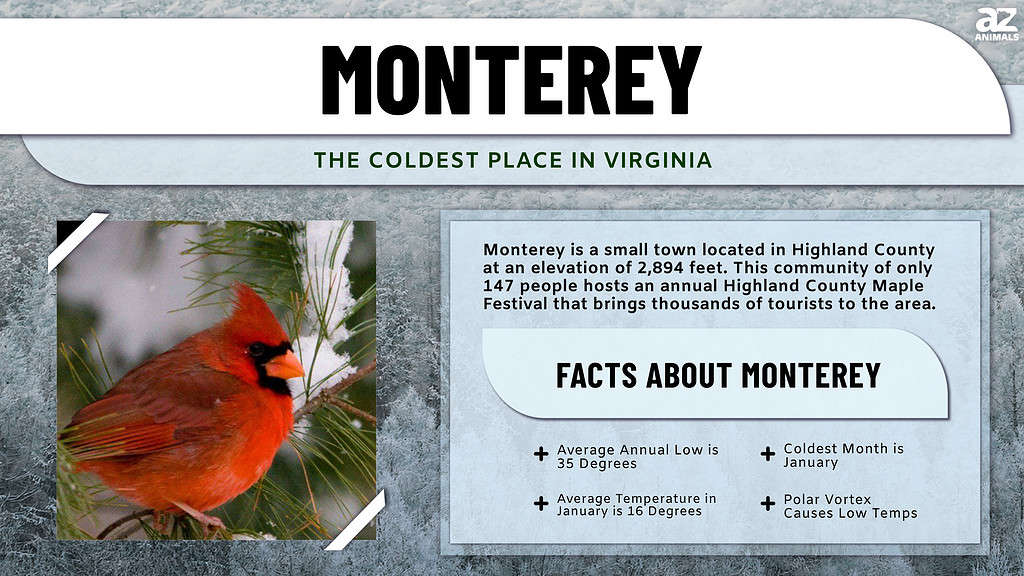Known as the Mother of Presidents, Virginia is home to a rich history. Here, you can find many historical sites and museums, with some being older than the United States itself. It’s also home to a diverse climate, thanks to its coastal regions and mountains. But where exactly is the coldest place in Virginia?
Keep reading to find out!
Average Climate in Virginia
Overall, the average climate in Virginia can be classified as a humid subtropical climate. As you move further west, towards the Blue Ridge Mountains, however, you’ll notice that the climate transitions to more of what is known as a humid continental climate.
Humid continental climates are known for their variable weather. This means that weather patterns and temperatures can easily change, and one year may not resemble the next in terms of climate. This is because of the location of humid continental climates, which expose it to a variety of different pressure systems.
How Cold Can it Get in Virginia?
In the coldest months of winter, Virginia can reach temperatures as low as 26 degrees Fahrenheit. In the summer, however, thanks to its positioning on the Atlantic Ocean and near the Gulf Steam, you’ll notice that the state can easily reach highs of around 86 degrees.
Like many other southern states, Virginia is at risk for hurricanes during the later months of summer. However, there is also a concern about tornados in the state, thanks to the variable climate. The state has an average amount of precipitation, with an annual measurement of around 44 inches.

What Is the Coldest Place in Virginia?
Overall, Virginia can be a fairly chilly place. This is especially true once winter comes around in the western parts of the state where the Blue Ridge Mountains are. However, what is the coldest place in Virginia? Look no further than Monterey, Virginia.
The average annual low in Monterey is around 35 degrees. Its coldest month is January, when it can easily reach an average low of around 16 degrees.

By average temperature, Monterey is the coldest place in Virginia, a town in Highland County.
©Kristi Blokhin/Shutterstock.com
About Monterey
Monterey is a small town in Highland County. In 2010, its population was only 147. It has an elevation of 2,894 feet, which is one reason for its exceptionally low averages.
Despite being a small town for most of the year, many people get to experience the brisk weather of Monterey in March of every year. This is because this is the time when the coldest place in Virginia hosts its annual Highland County Maple Festival. This two-weekend festival typically brings around 50,000 tourists to the area.
Coldest Temperature Recorded in Virginia
Although Monterey is the coldest place in Virginia for most of the year, it’s actually not home to the coldest temperature ever recorded in Virginia.
Instead, you can find the coldest temperature ever at Mountain Lake. Thanks to its elevated, mountainous terrain, Mountain Lake causes cold air to collect and pool, causing the temperatures to plummet. Paired with state-wide weather changes, it can easily reach below-freezing temperatures at this location.
On January 21, 1985, Mountain Lake reached a record-breaking low of -30 degrees Fahrenheit. This makes it the coldest temperature ever recorded in Virginia.
What Caused These Cold Temperatures?
Mountain Lake isn’t actually alone in this temperature plummet. Suppose you were to look at a variety of different states across the United States in January 1985. In that case, you’d notice that almost all of them experienced their coldest temperatures ever recorded around the end of the month. So, what caused this national freeze?
Known as the 1985 North America cold wave, the polar vortex caused these widespread freezing temperatures. You see, there are many different causes of weather. You may have noticed that storms or increased rain make the temperature colder. Although some of this has to do with cloud coverage, it also has to do with factors such as humidity and air pressure. That’s where the polar vortex comes in.
What is a Polar Vortex?
The polar vortex isn’t a storm or weather condition in the way that you might typically think of. Instead, it’s a permanent feature of the north and south poles. The polar vortex is a pool of low-pressure and colder temperatures. During the summer, it’s not as noticeable. This is because it tends to stay around the poles. However, during winter, the polar vortex can grow stronger and larger. This allows for its effects to be felt in the United States.
This is exactly what happened in Virginia, and in many other states, in 1985. The polar vortex sent freezing temperatures further south into the United States. This big freeze resulted in record-breaking temperatures that haven’t been seen since in many areas. Between the unusual weather and the new dangers presented as a result of this cold wave, the 1985 North American cold wave is one for the history books.
The photo featured at the top of this post is © Jon Bilous/Shutterstock.com
Sources
- University of California, Davis, Available here: https://soilhealth.ucdavis.edu/climatic-zones/humid-subtropical
- LibreTexts, Available here: https://geo.libretexts.org/Bookshelves/Geography_(Physical)/The_Physical_Environment_(Ritter)/09%3A_Climate_Systems/9.05%3A_Midlatitude_and_Subtropical_Climates/9.5.05%3A_Humid_Continental_Climate
Thank you for reading! Have some feedback for us? Contact the AZ Animals editorial team.






